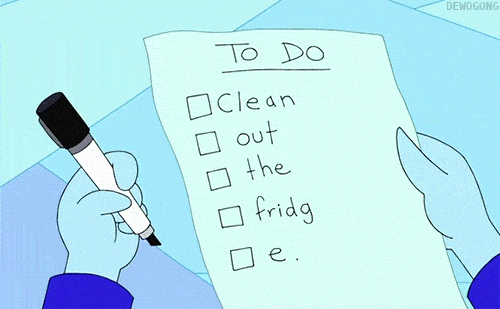When a problem is large or complex, and the optimal solution is unclear, do you spend too much time and energy spinning yourself in circles trying to figure out what to do?
Here’s a technique that will allow you to begin making progress towards a solution — even though you can’t visualize the entire path from your starting point.
Make your own rules to boost your productivity
Suppose your goal is to climb to the peak of a mountain, but there’s no trail to follow. You could try creating your own heuristic — a sort of shortcut: a set of rules that can help you solve problems faster than if you stopped and took time to calculate the best possible answer.
An example of a heuristic would be: Head directly towards the peak until you reach an obstacle you can’t cross. Whenever you reach such an obstacle, follow it around to the right until you’re able to head towards the peak once again. (This isn’t the most intelligent or comprehensive heuristic, but in many cases it will work just fine, and you’ll eventually reach the peak.)
Heuristics don’t guarantee you’ll find the optimal solution, nor do they generally guarantee a solution at all — but they do a good enough job of solving certain types of problems to be useful. Their strength is that they break the deadlock of indecision and get you into action.
As you take action, you begin to explore the solution space, which deepens your understanding of the problem. As you gain knowledge about the problem, you can make course corrections along the way, gradually improving your chances of finding a solution.
If you try to solve a problem you don’t initially know how to solve, you’ll often figure out a solution as you go — one you never could have imagined until you started moving. This is especially true with creative work, such as writing a book or software development: Often you don’t even know exactly what you’re trying to build until you start building it.
47 rules to boost your productivity
Heuristics have many practical applications, and one of my favorite areas of application is personal productivity. Productivity heuristics are behavioral rules (some general, some situation-specific) that can help us get things done more efficiently. Here are some of my favorites:
1) Daily goals. Without a clear focus, it’s too easy to succumb to distractions. Set targets for each day in advance. Decide what you’ll do — then do it.
2) Worst first. To defeat procrastination learn to tackle your most unpleasant task first thing in the morning instead of delaying it until later in the day. This small victory will set the tone for a very productive day.
3) Mini-milestones. When you begin a task, identify the target you must reach before you can stop working. For example, when working on a book, you could decide not to get up until you’ve written at least 1000 words. Hit your target no matter what.
4) Timeboxing. Give yourself a fixed time period, like 30 minutes, to make a dent in a task. Don’t worry about how far you get. Just put in the time.
5) Dailies. Schedule a specific time each day for working on a particular task or habit. One hour a day could leave you with a finished book, or a profitable Internet business a year later.
6) Peak times. Identify your peak cycles of productivity, and schedule your most important tasks for those times. Work on minor tasks during your non-peak times.
7) Resonance. Visualize your goal as already having been accomplished. Put yourself into a state of actually being there. Make it real in your mind, and you’ll soon see it in your reality.
8) Glittering prizes. Give yourself frequent rewards for achievement. See a movie, book a professional massage, or spend a day at an amusement park.
9) No-comm zones. Allocate uninterruptible blocks of time for solo work where you must concentrate. Schedule light, interruptible tasks for your open-comm periods, and more challenging projects for your no-comm periods.
MORE: Procrastinating? Don’t be ruled by your mood
10) Add-ons. Tack a task you want to turn into a habit onto one of your existing habits. For example, water the plants after you eat lunch. Send thank-you notes after you check email.
11) Batching. Batch similar tasks like phone calls or errands into a single chunk, and knock them off in a single session.
12) Double-up. Inject one task into the middle of another. Read while eating lunch. Return phone calls while commuting. Listen to podcasts while grocery shopping.
13) Recapture. Reclaim other people’s poor time usage for yourself. Visualize your goals during dull speeches. Write out your grocery list during pointless meetings. Clean out your purse or wallet while waiting for someone.
>> Printable priority planners to help manage your schedule
14) Gap reading. Keep a few ebooks on your phone, and use reading to fill in those odd periods like waiting for an appointment, standing in line, or while the coffee is brewing. That’s 365 articles a year.
15) Early bird. Get up early in the morning, like at 5am, and go straight to work on your most important task. You can often get more done before 8am than most people do in a day.
16) Cone of silence. Take a laptop with no network or WiFi access, and go to a place where you can work flat out without distractions, such as a library, park, coffee house, or your own backyard. Leave your comm gadgets behind.
17) Tempo. Deliberately pick up the pace, and try to move a little faster than usual. Speak faster. Walk faster. Type faster. Read faster. Go home sooner. Get some tips here: Forget slow! Try working fast.
18) Do it now! Recite this phrase over and over until you’re so sick of it that you cave in and get to work.
19) Declutter. Reduce stress by cultivating a relaxing, clutter-free workspace. See 18 five-minute decluttering tips to help you get organized.
20) Agendas. Provide clear written agendas to meeting participants in advance. This greatly improves meeting focus and efficiency. You can use it for phone calls, too.
21) Pareto. The Pareto principle is the 80-20 rule, which states that 80% of the value of a task comes from 20% of the effort. Focus your energy on that critical 20%, and don’t overengineer the non-critical 80%.
22) Ready-fire-aim. Bust procrastination by taking action immediately after setting a goal, even if the action isn’t perfectly planned. You can always adjust course along the way.
23) Do a Scotty. Estimate how long a task will take to complete, then start a timer, and push yourself to complete it in half that time.
24) Captain Kirk it. Lacking confidence? If you boldly and brazenly act like you know what you’re doing, people will assume it’s true.
25) Minute to win it. Once you have the information you need to make a decision, start a timer and give yourself just 60 seconds to make the actual decision. Take a whole minute to vacillate and second-guess yourself all you want, but come out the other end with a clear choice. Once your decision is made, take some kind of action to set it in motion.
26) Model. Find people who are already getting the results you want, interview them, and model their attitudes, beliefs and behavior.
27) Deadline. Set a deadline for task completion, and use it as a focal point to stay on track.
28) Promise. Tell others of your commitments, since they’ll help hold you accountable.
29) Punctuality. Whatever it takes, show up on time. Arrive early.
30) Continuum. At the end of your workday, identify the first task you’ll work on the next day, and set out the materials in advance. The next day, begin working on that task immediately.
31) Urgent vs important. Separate the truly important tasks from the merely urgent. Allocate blocks of time to work on the life-critical tasks — those which are important but rarely urgent, such as physical exercise, writing a book, and finding a relationship partner.
32) Conscious procrastination. Delay non-critical tasks as long as you possibly can. Many of them will die on you, and won’t need to be done at all.
33) Nuke it! The most efficient way to get through a task is to delete it. If it doesn’t need to be done, get it off your to-do list. Save the lives of your important projects by killing those that are going to die anyway.
34) Single-handling. Once you begin a task, stick with it until it’s 100% complete. Don’t switch tasks in the middle. When distractions come up, jot them down to be dealt with later.
35) Randomize. Pick a totally random piece of a larger project, and complete it. Pay one random bill. Make one phone call. Write page 42 of your book.
36) Slice and dice. Break complex projects into smaller, well-defined tasks. Focus on completing just one of those tasks.
37) Inspiration. Read inspiring books and articles, listen to audio programs, and attend seminars to keep absorbing inspiring new ideas (as well as to refresh yourself on the old ones).
38) Delegate. Convince someone else to do something for you. You could swap them a favor or pay them.
39) Troll hunt. Banish the negative trolls from your life, and associate only with positive, happy, and successful people. Mindsets are contagious. Show loyalty to your potential, not to your pity posse.
ALSO SEE: 8 things to say instead of ‘I don’t feel like it’
40) Insanely bad. Defeat perfectionism by completing your task in an intentionally terrible fashion, knowing you need never share the results with anyone. Write a blog post about the taste of salt, design a hideously dysfunctional web site, or create a business plan that guarantees a first-year bankruptcy. With a truly horrendous first draft, you at least have a start — and there’s nowhere to go but up.
41) Exercise daily. Boost your metabolism, concentration, and mental clarity in 30 minutes a day.
42) Nonconformist. Run errands at unpopular times to avoid crowds. Shop just before stores close or shortly after they open. Take advantage of 24-hour outlets if you’re an insomniac or a vampire.
43) Do it online. Shop online whenever possible. Get the best selection, consult reviews, and purchase items within minutes.
44) 30 days. Identify a new habit you’d like to form, and commit to sticking with it for just 30 days. A temporary commitment is much easier to keep than a permanent one.
45) Cross-pollination. Sign up for martial arts, start a blog, or join an improv group. You’ll often encounter ideas in one field that can boost your performance in another.
46) Optimization. Identify the processes you use most often, and write them down step-by-step. Refactor them on paper for greater efficiency. Then implement and test your improved processes. Sometimes we just can’t see what’s right in front of us until we examine it under a microscope.
47) Trust your intuition. Go with your gut instinct. It’s probably right.













